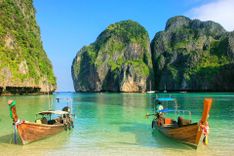Hot springs, spas and traditional massage
Just because you’re hundreds of kilometres from the nearest beach, that doesn’t mean you can’t enjoy a good soak. The Pai area is home to some natural hot springs and a clutch of decent spas, all of which offer massages.
Accessible from the minor road south from Wat Mae Yen, 2km beyond Joy Elephant Camp, are some hot springs, part of Huai Nam Dang National Park, which have one or two very hot, rough pools that aren’t really up to much. Much better than the pools, however, are the nearby spas, which put the piped hot water from the springs to more productive use. Pai Hotsprings Spa Resort, down a side road about 1km north of the springs, has two shady mineral pools and provides various massages, plus accommodation with spa-water bathrooms.
Massages are also available at several spots in town, including Mr Jan’s guesthouse, famous for its Thai and Burmese/Shan massages and saunas. Having trained at the Old Medicine Hospital in Chiang Mai, the staff at Pai Traditional Thai Massage (PTTM) on Thanon Tessaban 1 have a good reputation for traditional massages, as well as foot, herbal and oil massages and saunas, and run government-approved, three-day massage courses.
Activities around Pai
Away from the main hubbub of central Pai, there’s plenty to keep you occupied. Several undemanding walks can be made around Pai’s broad, gently sloping valley. The easiest – a round-trip of about an hour – takes you across the river bridge on the east side of town and up the hill to Wat Mae Yen, which commands a great view over the whole district. On the way to the wat, you’ll pass Fluid, the town’s large open-air swimming pool, with food and drink available, as well as fitness equipment, a steam room and yoga classes.
To the west of town, beyond Pai Hospital, the continuation of Thanon Chaisongkhram passes, after 3km, Wat Nam Hu, whose Buddha image has an unusual hinged topknot containing holy water. As you continue, the road gradually climbs through comparatively developed Thai Yai, Kuomintang (with a Chinese Cultural Centre where you can taste tea), Lisu and Lahu villages to Mo Pang Falls, with a pool for swimming, about 10km west of Pai.
Among several elephant camps on the minor road from Mae Yen towards the hot springs, Joy, 5km from town, charges B300 per hour per person for an elephant ride (minimum two people), which includes going into the river with the elephant and feeding it, as well as a free bathe in a hot spring pool.
The Pai Cookery School, Thanon Wan Chalerm, holds Thai cooking courses of one to three days, including a trip to the market to learn about ingredients, making six dishes, eating them and getting a free recipe book; vegetarians are catered for.
As befits a town that’s popular with spiritual types, there are several places offering yoga classes to beginners and experienced practitioners. At Xhale Yoga certified tutor Bhud runs daily drop-in classes at 10am. Alternatively you can join one of her highly recommended five-night yoga retreats.
Pai makes a good base for trekking, which can be arranged through the guesthouses or trekking agents, among which Duang Guest House, Thai Adventure Rafting and Back Trax at 17 Thanon Chaisongkhram are reliable.
Thai Adventure Rafting head off to friendly, hassle-free Karen, Lisu and Lahu villages to the north of Soppong near the border, taking in Tham Lot, some beautiful scenery and, in the rainy season, waterfalls. Their one-day treks head north of Pai. Both Duang and Thai Adventure Rafting can add bamboo rafting and can arrange one-way treks to Mae Hong Son (5–7 days), while Duang also offer sightseeing tours.
If you just fancy a bit of bamboo-rafting without the trekking, Duang and plenty of other agents can arrange transport and a two-hour trip down the Pai River for around B500 per person.
With a little more cash to spare, you could strike up with the reliable and experienced, French-run Thai Adventure Rafting for a rubber-raft trip. Heading down the Pai River to Mae Hong Son, you’ll pass through gorges and sixty rapids (up to class IV) and take in waterfalls and hot springs. The full journey lasts two days, including a night at a comfortable jungle camp by the river, though one-day trips are also available; the season normally runs from mid-June to the middle of February, with the highest water from August to early September, and participants must be able to swim.
Thinking of travelling to Thailand? Start planning by learning about how to get to there.





